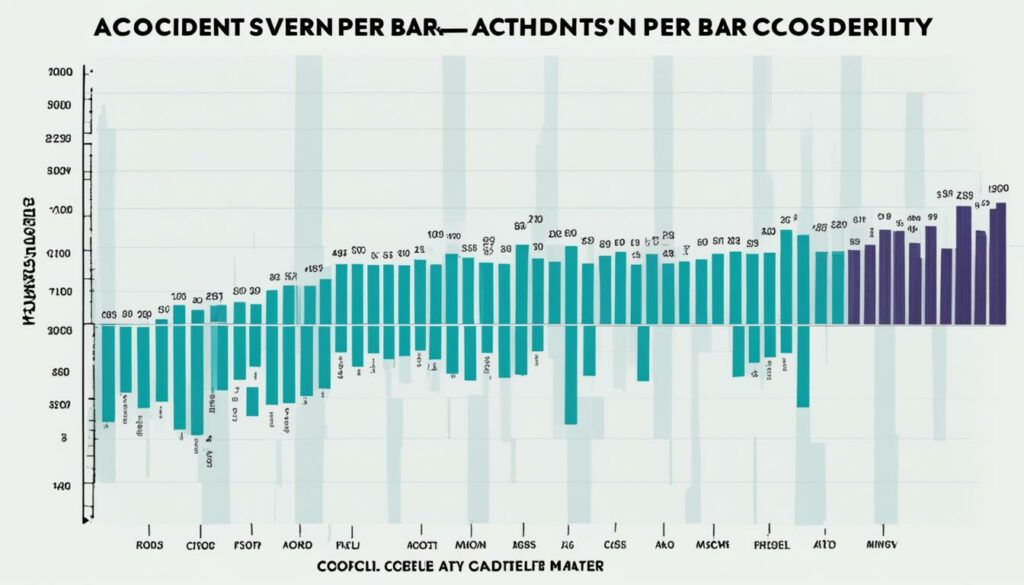How Safe is Driving? Understanding Road Safety
Road safety is a critical concern for all drivers. Understanding the importance of safe driving practices and implementing appropriate driving safety measures is essential to ensure the well-being of both drivers and other road users. In this article, we will explore the reality of road safety and delve into some statistics on driving safety.
Key Takeaways:
- Safe driving practices are crucial for preventing accidents and ensuring the safety of yourself and others on the road.
- Important safe driving tips include keeping 100% attention on driving, avoiding distractions, obeying speed limits, practicing defensive driving techniques, wearing seat belts, and avoiding driving under the influence.
- Various driving safety measures can be implemented, such as maintaining a safe distance between vehicles, properly securing cargo, being aware of other drivers’ behaviors, recognizing potential risks on the road, and ensuring vehicle maintenance.
- Road safety statistics highlight the need to promote safe driving practices and implement effective road safety measures.
- Ensuring child safety on the road involves using proper car seats and educating children about school bus safety.
Importance of Safe Driving Practices

Safe driving practices are crucial in ensuring the well-being of both drivers and other road users. By following these tips, you can significantly reduce the risk of road accidents and create a safer driving environment for everyone:
- Keep 100% attention on driving: Avoid distractions such as using electronic devices while driving. Focus solely on the task at hand to maintain full awareness of the road.
- Obey speed limits: Adhere to the speed limits set for different road conditions. Driving within the designated speed limits allows for better control and reduces the likelihood of accidents.
- Practice defensive driving techniques: Anticipate potential hazards and be prepared to respond appropriately. Stay alert, maintain a safe distance from other vehicles, and adjust your driving behavior to ensure maximum safety.
- Wear seat belts: Always buckle up before starting your journey. Seat belts are a vital safety measure that can prevent serious injuries in the event of a collision.
- Avoid driving under the influence: Never drive when you are under the influence of alcohol or drugs. Impaired driving significantly impairs your ability to react and increases the risk of accidents.
Maintaining safe driving habits is not just a legal obligation but also a moral responsibility. By prioritizing safe driving practices, we can protect ourselves and others on the road.
Stay Alert, Stay Safe
One of the most important aspects of safe driving is staying alert and focused on the road. Avoid any form of distraction that takes your attention away from the task at hand. Whether it’s texting, talking on the phone, or engaging in any other activity that diverts your attention, it can have disastrous consequences.
Remember that safe driving is not just about following traffic rules; it’s about being proactive and mindful of your surroundings. By cultivating good driving habits and prioritizing safety, you contribute to making our roads safer for everyone.
Driving Safety Measures

Enhancing road safety requires the implementation of various driving safety measures. By following these measures, drivers can significantly reduce the likelihood of accidents and promote safer driving environments.
- Maintain a safe distance between vehicles: Keeping a safe following distance allows drivers to react and brake in time to avoid collisions. Adhering to the recommended two-second rule can minimize the risk of rear-end accidents.
- Properly secure cargo: When transporting cargo, it is crucial to secure it properly to prevent any items from becoming projectiles in the event of sudden stops or collisions. Secure cargo with straps, nets, or other appropriate restraints.
- Be aware of other drivers’ behaviors: Keeping a vigilant eye on other drivers’ actions can help anticipate potential hazards. Stay attentive to turn signals, lane changes, and erratic driving behavior to react accordingly.
- Recognize potential risks on the road: Being proactive in identifying potential risks, such as potholes, construction zones, or hazardous weather conditions, allows drivers to make informed decisions and adjust their driving accordingly.
- Ensure that vehicles are well-maintained: Regular vehicle maintenance, including brakes, tires, lights, and fluids, is essential to keep vehicles in optimal condition. Properly maintained vehicles are less likely to experience mechanical failures that could lead to accidents.
By incorporating these driving safety measures into their daily routines, drivers can actively contribute to creating safer roadways for everyone.
Understanding Road Safety Statistics

Road safety statistics provide valuable insights into the current state of driving safety and highlight areas that require attention. It is crucial to understand the scope of the issue to effectively address it and promote safer driving practices. Let’s explore some driving safety statistics and facts.
“Motor vehicle crashes result in over 1 million deaths worldwide each year, with an estimated 20 to 50 million serious injuries.” – World Health Organization (WHO)
In the United States alone, driving-related accidents have significant consequences. On average, approximately 37,000 people are killed each year, and 2.3 million are injured in motor vehicle crashes. These statistics paint a stark picture of the risks involved in driving and emphasize the importance of prioritizing road safety.
To prevent accidents and promote safer roads, it is essential to implement effective road safety measures. By understanding the data and statistics, we gain valuable insights that can guide us in developing strategies and interventions to reduce the number of accidents and create a safer driving environment.
Through education, awareness campaigns, and enforcement of safe driving practices, we can work towards minimizing the impact of accidents on individuals and communities. By prioritizing road safety and adopting responsible driving habits, we can contribute to a future with fewer accidents and a higher level of safety on the road.
| Country/Region | Annual Motor Vehicle Deaths | Annual Motor Vehicle Injuries |
|---|---|---|
| United States | 37,000 | 2.3 million |
| Worldwide | 1 million | 20-50 million |
Ensuring Child Safety on the Road
Child safety is of utmost importance when it comes to driving. As parents and caregivers, it is our responsibility to take all necessary measures to protect our children while on the road. One crucial aspect of child safety is the proper use of car seats.
Using the correct car seat for your child’s age, weight, and height can significantly reduce the risk of injury or death in the event of an accident. It’s essential to choose a car seat that meets all safety standards and install it correctly in your vehicle. Remember to always follow the manufacturer’s instructions for proper installation and use.
Additionally, it is vital to educate children about school bus safety. Riding the school bus is a common mode of transportation for many children, and understanding how to stay safe on a school bus is crucial.
Here are some key safety tips to teach children:
- Always wait for the school bus in a safe location away from traffic.
- When boarding the bus, wait for it to come to a complete stop and use the handrail while getting on.
- Find a seat quickly and remain seated for the duration of the ride.
- Keep backpacks and other belongings out of the aisle to avoid tripping hazards.
- Follow the bus driver’s instructions and be respectful to other passengers.
- When getting off the bus, wait for it to come to a complete stop before exiting and always cross the road in front of the bus, never behind it.
By prioritizing child safety and teaching children about the importance of proper car seat use and school bus safety, we can help protect our youngest passengers and reduce the risks they face on the road.
Promoting Teen Driving Safety

When it comes to teenagers transitioning to independent driving, it is crucial to prioritize their safety on the road. Providing proper education and guidance can help promote safe driving practices among young drivers. By equipping them with the necessary knowledge and skills, we can significantly reduce the number of accidents involving teenage drivers.
One key aspect of promoting teen driving safety is parental involvement. Parents play a vital role in shaping their teen’s behavior behind the wheel. By setting a good example, discussing safe driving practices, and enforcing rules, parents can instill responsible driving habits in their teenage children.
Driver education programs also play a crucial role in preparing young drivers for the challenges of the road. These programs provide comprehensive training on various aspects of safe driving, including defensive driving techniques, understanding traffic laws, and handling different driving scenarios. By participating in driver education programs, teenagers can gain the necessary skills and knowledge to navigate the roads safely.
Furthermore, implementing graduated driver licensing systems can help mitigate the risks associated with teenage driving. These systems gradually introduce driving privileges and restrictions, allowing young drivers to gain experience in controlled environments before obtaining full driving privileges. By gradually increasing their exposure to driving scenarios, teenagers can develop the necessary skills and confidence to drive safely.
“Proper education, parental involvement, and graduated driver licensing systems are key factors in promoting teen driving safety.”
The Impact of Teen Driver Education Programs
Teen driver education programs have shown promising results in improving road safety for young drivers. According to a study conducted by the National Highway Traffic Safety Administration (NHTSA), teens who participated in driver education programs experienced a 40% reduction in crashes and a 51% decrease in traffic violations.
These programs provide opportunities for young drivers to learn from experienced instructors, practice their skills in controlled environments, and gain valuable knowledge about safe driving practices. Additionally, they often include interactive activities and simulations that help teenagers understand the potential risks and consequences of unsafe driving behaviors.
Safe Driving Tips for Teens
“Always remember, as a teenager behind the wheel, you have the responsibility to drive safely and protect yourself and others on the road. Stay focused, avoid distractions, follow traffic rules, and never drive under the influence. Your safety and the safety of others depend on your responsible choices.”
Here are some essential safe driving tips for teens:
- Always wear seat belts and ensure that all passengers do the same.
- Avoid using electronic devices while driving, as they can be major distractions.
- Observe speed limits and adjust your speed according to road conditions.
- Leave enough space between your vehicle and the one in front of you.
- Use turn signals to indicate your intentions to other drivers.
- Avoid aggressive driving behaviors such as tailgating or weaving through traffic.
- Stay vigilant and anticipate potential hazards on the road.
Remember, safe driving is a lifelong commitment. By developing responsible driving habits early on, teenagers can set themselves up for a lifetime of safe and responsible driving.
Addressing Older Driver Safety

As individuals age, changes in physical and cognitive abilities can pose challenges to safe driving. Recognizing these changes and addressing them appropriately is crucial to maintaining older drivers’ safety. Regular evaluations, discussions with healthcare professionals, and consideration of alternative transportation options can help ensure the well-being of older drivers and those sharing the road with them.
Recognizing Changes in Driving Abilities
Older drivers may experience a decline in certain abilities that can affect their driving performance. These changes may include:
- Slower reaction times
- Decreased vision and hearing
- Impaired cognitive function
- Stiff joints and reduced flexibility
It is important for older drivers to recognize these changes and take appropriate measures to compensate for them. This may involve adjusting driving habits, using assistive devices such as glasses or hearing aids, or seeking alternative transportation options when necessary.
Regular Evaluations and Discussions with Healthcare Professionals
Older drivers should undergo regular evaluations of their driving abilities. This can be done through comprehensive driving assessments conducted by trained professionals. These evaluations assess physical, cognitive, and visual abilities relevant to safe driving. By identifying areas of concern, older drivers can work with healthcare professionals to develop strategies to address any limitations or challenges.
Discussions with healthcare professionals can also provide valuable insights and guidance on maintaining safe driving practices. Healthcare professionals can advise on medication side effects that may affect driving performance and provide recommendations for managing chronic conditions that may impact driving safety.
Exploring Alternative Transportation Options
For older drivers who may no longer be able to drive safely, exploring alternative transportation options is essential. This can include using public transportation, utilizing ride-sharing services, or relying on family and friends for transportation needs. By embracing alternative transportation options, older drivers can prioritize their safety while still maintaining their mobility and independence.
Summary
Recognizing the changes in driving abilities that come with age is crucial for older drivers’ safety. Regular evaluations and discussions with healthcare professionals can help older drivers address any challenges and develop strategies to compensate for limitations. Exploring alternative transportation options when necessary ensures the well-being of older drivers and promotes road safety for all.
| Key Points | Benefits |
|---|---|
| Recognize changes in driving abilities | • Improve self-awareness • Take appropriate measures |
| Regular evaluations and discussions with healthcare professionals | • Identify areas of concern • Develop strategies for safe driving |
| Exploring alternative transportation options | • Prioritize safety • Maintain mobility and independence |
Enhancing Pedestrian and Bicycle Safety
Pedestrian safety and bicycle safety are crucial aspects of road safety that deserve equal attention. It is essential to raise awareness about the potential dangers that pedestrians face and provide them with essential tips to stay safe while walking. Additionally, educating motorists about sharing the road with cyclists can greatly reduce the number of accidents involving vulnerable road users.
By promoting mutual respect and understanding between all road users, we can create safer environments for both pedestrians and cyclists. Let’s explore some effective strategies and safety measures that can enhance pedestrian and bicycle safety:
For Pedestrians:
- Stay alert and attentive: Always pay attention to your surroundings and avoid distractions like using electronic devices.
- Use designated crosswalks: Cross the road at designated crosswalks or intersections, following traffic signals and pedestrian signs.
- Maintain visibility: Wear bright or reflective clothing, especially when walking at night or in low-light conditions.
- Make eye contact: When crossing in front of vehicles, make eye contact with the driver to ensure they have seen you.
- Walk against traffic: If there are no sidewalks, walk on the side of the road facing the oncoming traffic.
For Motorists:
- Give pedestrians the right of way: Yield to pedestrians at crosswalks and intersections, allowing them to safely cross the road.
- Maintain a safe distance: Leave ample space between your vehicle and pedestrians, especially when passing or overtaking them.
- Look out for cyclists: Check your blind spots before making turns or changing lanes to avoid colliding with cyclists.
- Use turn signals: Indicate your intentions to other road users, giving them time to react and adjust their movements accordingly.
- Share the road: Treat cyclists as legitimate road users, giving them enough space and respecting their right to use the road.
“Sharing the road means showing mutual respect, understanding, and consideration for all road users.”
By implementing these safety measures and fostering a culture of respect and understanding, we can create a safer road environment for pedestrians, cyclists, and motorists alike.
Motorcycle Safety and Awareness
Motorcyclists face unique safety concerns on the road due to their vulnerability. It is crucial for all drivers to understand and anticipate motorcyclists’ behavior, providing them with adequate space and promoting awareness.
Sharing the road with motorcycles requires a culture of mutual respect and understanding. By following these key tips, both motorcyclists and drivers can contribute to reducing motorcycle accidents:
- Keep a safe distance: Maintain a safe following distance when sharing the road with motorcycles. Motorcycles have a shorter stopping distance compared to cars, so allow them enough space to maneuver.
- Stay alert: Always stay focused and attentive while driving to anticipate the movements of motorcycles. Due to their smaller size, motorcycles may be harder to spot, especially in blind spots.
- Use turn signals: Signal your intentions early and clearly to give motorcyclists enough time to react. This helps them anticipate your movements and avoid potential collisions.
- Check blind spots: Before changing lanes or making a turn, check your blind spots carefully. Motorcycles can easily disappear from view, so it’s important to double-check before making any maneuvers.
- Adhere to speed limits: Obey posted speed limits and adjust your speed accordingly in areas where motorcycles are commonly present. Excessive speed can make it difficult to react quickly in case of unexpected motorcycle maneuvers.
- Look out for motorcyclists in intersections: Motorcycles are more vulnerable during intersection crossings. Always check intersection traffic carefully before proceeding to avoid potential accidents.
By following these safety measures and fostering a culture of awareness and respect on the road, we can create a safer environment for motorcyclists and reduce the incidence of motorcycle accidents.
Motorcycle Safety Statistics
| Statistical Insight | Information |
|---|---|
| Motorcycle Fatalities in the US | According to the National Highway Traffic Safety Administration (NHTSA), in 2019, there were 5,014 motorcycle fatalities in the United States. This accounted for 14% of all traffic-related fatalities. |
| Risk of Death | Motorcyclists are approximately 29 times more likely to be involved in a fatal accident than passenger car occupants per mile traveled, as reported by the Insurance Institute for Highway Safety (IIHS). |
| Motorcycle Helmet Usage | Wearing helmets can significantly reduce the risk of severe head injuries and fatalities. The NHTSA estimates that helmets saved the lives of 1,872 motorcyclists in 2017. |
These statistics highlight the importance of prioritizing motorcycle safety and taking proactive measures to protect both motorcyclists and drivers on the road.
Road Safety and Public Health
Road safety is closely connected to public health, as motor vehicle crashes have a significant impact on the well-being of individuals and communities. These accidents result in injuries, disabilities, and fatalities, affecting the physical and mental health of those involved.
To address this issue, various initiatives and policies are being implemented to improve road safety and mitigate the negative health consequences of motor vehicle accidents. Public agencies, healthcare professionals, and advocacy organizations are collaborating to raise awareness and implement effective strategies to reduce accidents and their associated health risks.
By prioritizing road safety, we can protect the public’s health by preventing injuries, disabilities, and premature deaths caused by motor vehicle crashes. This requires a multi-faceted approach that includes enforcing traffic laws, promoting safe driving practices, improving infrastructure, and educating the public about road safety.
Furthermore, integrating road safety initiatives into public health programs can create a comprehensive approach that addresses both the immediate and long-term health impact of motor vehicle accidents. By recognizing road safety as a public health concern, we can work towards a safer and healthier society for all.
The Connection between Road Safety and Public Health
Motor vehicle crashes have far-reaching effects on public health:
“Road traffic accidents are a leading cause of death and injury worldwide, with a disproportionate impact on low- and middle-income countries.”
This quote from the World Health Organization highlights how road safety is a global health challenge. It underlines the urgent need for comprehensive road safety measures to protect public health on a global scale.
The consequences of motor vehicle accidents extend beyond immediate physical injuries. They also lead to long-term disabilities, psychological trauma, and increased healthcare costs. By addressing road safety as a public health issue, we can make significant progress in reducing these negative impacts and improving overall well-being.
Collaborative Efforts and Road Safety Initiatives
Addressing road safety as a public health concern requires collaboration among various stakeholders:
- Public agencies: Government bodies and transportation departments play a crucial role in implementing and enforcing road safety regulations. They work towards improving infrastructure, enhancing traffic management systems, and conducting campaigns to raise public awareness.
- Healthcare professionals: Medical practitioners and public health experts have a vital role in advocating for road safety. They provide support in the form of injury prevention, rehabilitation, and counseling services for accident victims.
- Advocacy organizations: Non-governmental organizations and advocacy groups play a crucial role in raising public awareness, pushing for policy changes, and promoting road safety initiatives.
By joining forces, these stakeholders can create a holistic approach to road safety that encompasses education, law enforcement, infrastructure improvements, and advocacy.
Road Safety Initiatives
| Initiative | Description |
|---|---|
| Safe Driving Campaigns | Public awareness campaigns promoting safe driving practices and educating the public about the importance of road safety. |
| Enhanced Infrastructure | Investments in road design improvements, such as traffic signal optimization, pedestrian-friendly infrastructure, and better signage. |
| Strict Law Enforcement | Enforcement of traffic laws to deter dangerous driving behaviors and reduce the number of traffic violations. |
| Driver Education Programs | Providing comprehensive driver education and training programs to ensure drivers are knowledgeable about safe driving practices. |
| Vehicle Safety Standards | Setting and enforcing safety regulations for vehicles, including mandatory safety features and regular vehicle inspections. |
These are just a few examples of the road safety initiatives that have been put into action to make our roads safer and protect public health. By continuing to invest in these initiatives and strengthening collaboration among stakeholders, we can strive towards a future with reduced accidents and improved public health outcomes.
Conclusion
Ensuring road safety is of utmost importance in our daily lives, as it directly impacts every individual on the road. By understanding the significance of safe driving practices, implementing effective driving safety measures, and raising awareness about road safety issues, we can significantly reduce the number of accidents and create safer driving environments for all.
By prioritizing road safety and practicing responsible driving habits, we can work together towards a future with fewer accidents and a higher level of safety on the road. It is crucial that all drivers maintain 100% attention while driving, avoid distractions, obey speed limits, practice defensive driving techniques, and wear seat belts. Additionally, avoiding driving under the influence of alcohol or drugs is essential for ensuring road safety.
By acknowledging the importance of road safety, we take a significant step towards protecting ourselves and others on the road. Let’s promote a culture of safe driving practices and make road safety a top priority for the well-being of everyone.
FAQ
How important is road safety?
Road safety is of utmost importance as it ensures the well-being of both drivers and other road users. Implementing safe driving practices and driving safety measures significantly reduce the risk of accidents and injuries.
What are some safe driving practices?
Some safe driving practices include keeping 100% attention on driving, avoiding distractions, obeying speed limits, practicing defensive driving techniques, wearing seat belts, and avoiding driving under the influence of alcohol or drugs.
How can driving safety be enhanced?
Driving safety can be enhanced by maintaining a safe distance between vehicles, properly securing cargo, being aware of other drivers’ behaviors, recognizing potential risks on the road, and ensuring that vehicles are well-maintained.
What are some driving safety statistics?
Motor vehicle crashes result in over 1 million deaths worldwide each year, with an estimated 20 to 50 million serious injuries. In the United States, an average of approximately 37,000 people are killed each year, and 2.3 million are injured in motor vehicle crashes.
How can child safety be ensured on the road?
Child safety can be ensured by properly installing and using the appropriate car seat for your child. Additionally, educating children about school bus safety is essential to mitigate potential risks while traveling to and from school.
How can teenage driving safety be promoted?
Teenage driving safety can be promoted through parental involvement, driver education programs, and implementing graduated driver licensing systems, which gradually introduce driving privileges to teens while providing guidance and restrictions.
How can older driver safety be addressed?
Older driver safety can be addressed by recognizing changes in physical and cognitive abilities, undergoing regular evaluations, discussing with healthcare professionals, and considering alternative transportation options if necessary.
How can pedestrian and bicycle safety be enhanced?
Pedestrian and bicycle safety can be enhanced by raising awareness about the dangers pedestrians face, providing tips on how to stay safe while walking, and educating motorists about sharing the road with cyclists.
How can motorcycle safety be promoted?
Motorcycle safety can be promoted by understanding and anticipating motorcyclists’ behavior, providing them with adequate space on the road, and promoting awareness among all drivers about sharing the road with motorcycles.
What is the connection between road safety and public health?
Motor vehicle crashes have a significant impact on public health, resulting in injuries, disabilities, and fatalities. Initiatives and policies are being implemented to improve road safety and mitigate the negative health consequences of motor vehicle accidents.
Why is road safety important?
Road safety is important because it ensures the well-being of all road users. By practicing safe driving habits and implementing effective driving safety measures, we can significantly reduce the number of accidents and create safer driving environments.






